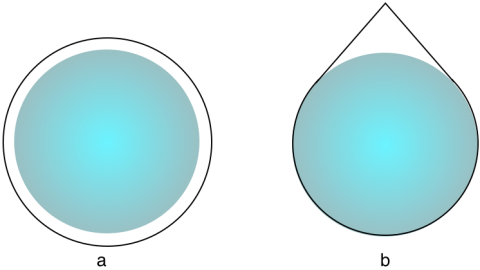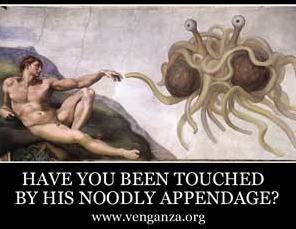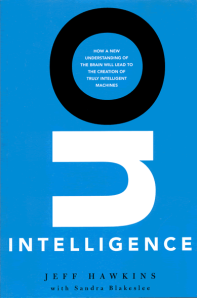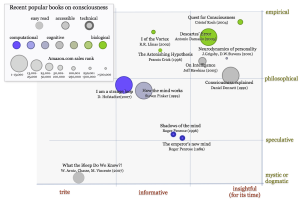Roping the Earth
2009/03/03
I have utterly enjoyed the very stimulating online physics book by Christoph Schiller Motion Mountain. It includes some 1700 challenges for the reader ranging from fun little puzzles to standing research problems. This is a great example of how textbooks should be written to engage the student.
Here is Challenge 70 from the book.
A rope is put around the Earth, on the Equator, as tightly as possible. The rope is then lengthened by 1 m. Can a mouse slip under the rope?
I have seen this problem previously and in both cases was dissatisfied with how understated the solution was. Schiller’s answer is:
Yes, it can. In fact, many cats can slip through as well.
The author’s reasoning must be as follows. Since the circumference of a circle is , then adding one meter to P adds 16 cm to the radius. Therefore, a cat could crawl under the rope. The result may be counterintuitive because of the huge proportions involved: 1 meter seems so insignificant to Earth’s circumference that it shouldn’t change anything. Yet mathematics must trump intuition’s whims.
However, this calculation assumes that the rope retains its circular shape and remains centered on Earth’s center (as in Figure a below). If one pulls the rope up as shown in Fig. b, the 1-meter slack will allow 121 meters of clearing under the rope. That’s enough to slip the Titanic under it, let alone `many cats.’

A rope around the earth
Here is the calculation as shown in the figure below. Imagine a tower h = 121.37 m high. Then the distance from the top of the tower to the horizon is , where
is the Earth radius. Meanwhile, the ground distance from the bottom of the tower to the same point on the horizon is
, a difference of only 0.5 m. Therefore, the straight path from the horizon to the top of the tower and again to the horizon on the opposite side is 1 m longer than the ground path between the two points on the horizon
.

Calculation of the height of the object that could be slipped under the rope lengthened by 1 meter.
Amazingly, adding just 1 mm of slack to the rope will make a clearing high enough for a child to walk under the rope: 1.25 m.
Aliasing in biological vision
2009/03/03
Moiré artifacts and other forms of aliasing often appear in electronic imaging systems due to insufficient sampling of the optical images. Spatial aliasing occurs when the optical image bandwidth exceeds that of the image detector. Spatial aliasing manifests itself when a TV host wears a fine-striped shirt, producing distracting moirés.
Temporal aliasing occurs when the temporal bandwidth of the imaged scene exceeds the frame rate of the camera. Temporal aliasing manifests itself in the wagon wheel illusion in a Western movie. A rotating wagon wheel will appear to freeze or even to reverse its rotation.
Why don’t biological systems experience aliasing — or do they? Does the eye or brain circuits exhibit aliasing and moiré phenomena?
The human eye appears to avoid spatial aliasing by supersampling the optical signal: the point spread function of the eye optics covers several photoreceptors. What limits the resolution of the eye is the optics. The cornea, aqueous humor, the lens, vitrous humor, and three layers of retinal cells in front of the photoreceptors blur the signal and efficiently remove the very high-frequency content in the image. In addition, the arrangement of photoreceptors is not strictly regular as happens in a CCD chip for example. Thus chances of producing a spatial moiré pattern in the eye are nil.
However, temporal or spatiotemporal aliasing may occur, probably in motion processing areas of the visual cortex. One manifestation of this glitch is the motion reversal illusion sometimes perceived when a spoked wheel accelerates and decelerates through a range of RPMs. Skeptical that this could be the result of the stroboscopic effect of electric lighting, I made a black-and-white pinwheel and spun it. Even in daylight, at some rotation rates, I perceived subtle and transient episodes of illusory reversal. You can try this for yourself.
Is this evidence that the visual system has a semi-regular ‘frame rate’ similar to video and film cameras? I found it hard to believe. Temporally subsampled signals indicate inefficiencies undercutting the quantum efficiency (ie overall sensitivity) of the system, a problem that’s too easily fixed by introducing additional blurring (low-pass filtering) to limit the bandwidth before sampling. Temporal blurring is something very easy for cells to do and evolution would have long found a way to blur the signal, even if vision did work in regular discontinuous frames. There has to be something else to account for the illusory motion reversal.
In a recent paper by Kline and Eagleman (2008) in the Journal of Vision titled “Evidence against the snapshot hypothesis of illusory motion reversal”, the authors staged a series of experiments that argued against the snapshot hypothesis (frame-rate hypothesis).
The experiments support the rivalry hypothesis of the illusory motion reversal, ie that “the continuous stimulation of one direction of motion eventually causes rivalry with the opposite direction of motion, and the balance of the rivalry eventually tips, engendering the perception of reversed motion”. In other words, motion detection is hypothesized to consist of multiple motion detectors that each have undersampled spatiotemporal responses, many of which produce aliasing. Normally, those motion detectors that detect correct motion are stimulated stronger than their aliased counterparts resulting in correct perception. However, in continuous exposure, the strongly stimulated detectors desensitize and the aliased detectors get their opinions heard. That’s the putative mechanism, but no specific circuits responsible for this illusion have yet been described.
Constructing a daemon to keep your cool
2009/02/11
Elizabeth Gilbert’s TED talk fell on grateful ears. Creative persons, she reasoned, inevitably face heightened risks of mental disorders and personal destruction as their psyche struggles to absorb successes and to pull through rejections and failures. Paralyzing self-doubt, fear of mediocrity, and destructive manias gain their potency from the modern rational belief that creativity comes from the individual’s talents and dedication. In the less rational times, the whispers of capricious tutelary daemons and the tuggings of unbridled universal forces guided generations of philosophers and poets while letting them live in calm. If so, Elizabeth Gilbert justifies and encourages keeping our daemons with us.
Surely, this recipe applies beyond the circle of professional writers and artists. Any practical advice for how to construct a sufficiently believable and at least partly personable daemon?
Do animals have souls?
2009/01/25
A while ago, I asked several coworkers, separately, whether they thought animals had souls. The two Mormons among them claimed that all living things all the way to prokaryotes and viruses had eternal spirits along with their physical bodies. The two Catholics argued that humans alone possessed minds and souls. All of them seemed somewhat confident in their responses so I thought I could generalize these respective beliefs to all Mormons and Catholics. Does any other faith stand elsewhere on the continuum between the all-inclusive Mormons and the soul-grudging Catholics? Do any creeds proclaim, for example, that only mammals have souls, but not reptiles and plants? — I think I could provide a few neurophysiological arguments to justify that position. Dog owners, for example, whatever their faith, will vouch for the existence of their best friend’s soul. Thus we make a testable prediction: any Catholic will disavow her faith after getting a puppy. I realize Catholics have grown quite diverse in their beliefs post-Vatican II. I must have simply run into the non-dog-owning kind — sampling error again.
Finally, who has the correct answer?
To answer these questions, I consult the preeminent objective source on all things spiritual and scientific, the Conservapedia. In its current article on the brain, Conservapedia cites the work of one René Descartes and his conclusion that the etherial soul controls the physical brain through the pineal gland. Conservapedia’s authors express doubts about the more modern and less satisfying descriptions of the function of the brain and the pineal gland in particular as they do not specifically provide room for free will and the eternal soul. The answer becomes clear: creatures that have a pineal gland also have souls while those that don’t, don’t.
Then let’s simply enumerate all animals that have a pineal gland and those that don’t. It turns out, all chordates have a form of the pineal gland or epiphysis and it contains cells homologous to retinal cells specific to chordates. Human embryos, clearly, don’t have a pineal gland and do not have souls, until at least the time when the epiphysis begins to develop in the fetus around the seventh week of gestation.
Ah, it feels great to finally have the answers — lampreys, fish, mice, and sheep have souls whereas bananas, insects, octopuses, and human embryos don’t. Next topic!
“On Intelligence” by Jeff Hawkins
2009/01/12
“On Intelligence” fulfills Jeff Hawkins‘ dream to encapsulate a basic theory of intelligence in a straightforward plainly written book. Written with science writer Sandra Blakeslee, “On Intelligence” combines Mr Hawkins’ motivational autobiography, a review of natural and artificial intelligence, and a philosophical discussion delivered in a no-nonsense, unembellished, yet stimulating narrative.
At its core, “On Intelligence” postulates that all higher cognitive functions are built on a single relatively simple algorithm replicated across the neocortex. This hypothetic “basic cortical algorithm” is described as a predictive autoassociative hierarchical network. Left to its own devices, such a neural network should spontaneously generate stable invariant representations of regularities in the environment giving birth to perception, behavior, thoughts, consciousness, and imagination. If we could only mimic Nature and build such a network in silicon, we should be able to make computers that learn, think, and imagine. Mr Hawkins admits that most of these ideas are not original and his contribution is to organize them into a coherent hypothetical framework.
How credible is Mr Hawkins’ hypothesis? How do we know the brain does this? How do we know that such an artificial model would exhibit animal-like intelligence? Mr Hawkins’ answer is: be optimistic — we are way overdue for some kind of a general theory of the brain. In a break from scientific form, Mr Hawkins does not seek out contradictory evidence. The autobiographical sections carry an air of a quixotic struggle against the errors and prejudices of the scientific and corporate establishments of the past and present, who lack the audacity to imagine that a comprehensive theory of intelligence could be within reach. In its more technical sections, the book identifies specific cortical structures responsible for these computations in rather computational than biological terms. No experimental evidence and no working computer models are described or reviewed critically. Instead, the key premises derive from introspection and personal interviews with authorities on the subject, e.g. “I had spoken to several … experts and asked them to explain…” Mr Hawkins mixes experimentally supported findings with speculation and swiftly decides standing controversies without identifying them as such, leaving a casual reader with an exaggerated impression of how much is understood about cognition. In this way, the book often reads rather like marketing material for a specific approach than a thoroughly researched thesis presenting latest scientific findings.
Every neuroscientist strives to intuit a fundamental principle behind the ocean of facts about the nervous system and every computer scientists dreams of creating systems that could develop intelligence. Yet Nature is slow to give up its recipes. By helping envision what the answers could be, “On Intelligence” stands to inspire the budding scientist and engineer with the confidence to probe into the most daunting natural phenomenon that is intelligence. And it is for its enthusiasm and inspiration that “On Intelligence” earns my four stars.
dappled designs
2008/08/10
image courtesy Edward Tufte
As sunlight passes through the crown of a tree, every small opening in the crown serves as the aperture of a pinhole camera that casts an image of the sun on the ground. These sun images vary in size and brightness and may overlap, forming shadows of intricate detail and rich intensity gradations.
Artists call this dappled light. As the sun makes its way across the sky, the shapes change relatively quickly (a property of the moiré phenomenon).
If we could carefully design a tree-shaped sculpture with precisely positioned twigs and leaves, we could make a sundial that marks the passage of times and seasons by casting intricately detailed transient shadow images. For example, a tree sculpture installation that casts shadow portraits of persons whose birthday it is on that day — every day of the year, at a specific time.
Wooden shadow mirror
2008/08/10
The artist Danny Rozin has created “mirrors” that create shadow images of the viewer by actuating simple elements such as blocks or pegs.
Popularizers of scientific consciousness
2008/07/07
Francis Crick was being coy when he titled his book “The astonishing hypothesis”: that all cognitive processes, including consciousness, are the product of neurons is much more than a hypothesis — it is a mature theory and a subject of active multidisciplinary investigation. The popularization of this insight may meet similar resistance as Darwin’s theory (although it may simply be lumped together with ‘Darwinism’). The view of consciousness as interaction of several mechanisms (or as Dan Dennett calls it, “a bag of tricks”) disagrees with the common sense notion of self as indivisible whole, the starting point in philosophical search (Cogito ergo sum). Therefore, all interesting philosophy of the next decades will be informed by recent experimental findings in neuroscience. Many authors are attempting to popularize the notions of neuronal nature of self. Others are taking advantage of the confusion to push a pet speculation or dogma.
Below I have compiled this chart with several books I have read that address questions of consciousness in intriguing ways. I rated these books based on how much new knowledge or insight they seemed to provide and whether these insights came by way of empirical findings or unfounded speculation. Click to enlarge.
Luckily, many popularizers of scientific understanding of mind and consciousness have made public presentations that are now available online. These make good previews of the contents of their books, and, if you have a couple of hours, getting to know these people will be time well spent.
Daniel Dennett:
Lectures on consciousness:
Jeff Hawkins, “On intelligence”
Christof Koch, “The Quest for Consciousness”
Reflection on self-awareness
2008/06/13
Recognizing self in the mirror is an established test of self-awareness. Humans and the great apes are alone in the animal kingdom to pass it.
We humans go a bit too far and insist on it, with embarrassing results:
I wonder how a mirror-trained bonobo would respond to this prank. How about a six-year-old child?






